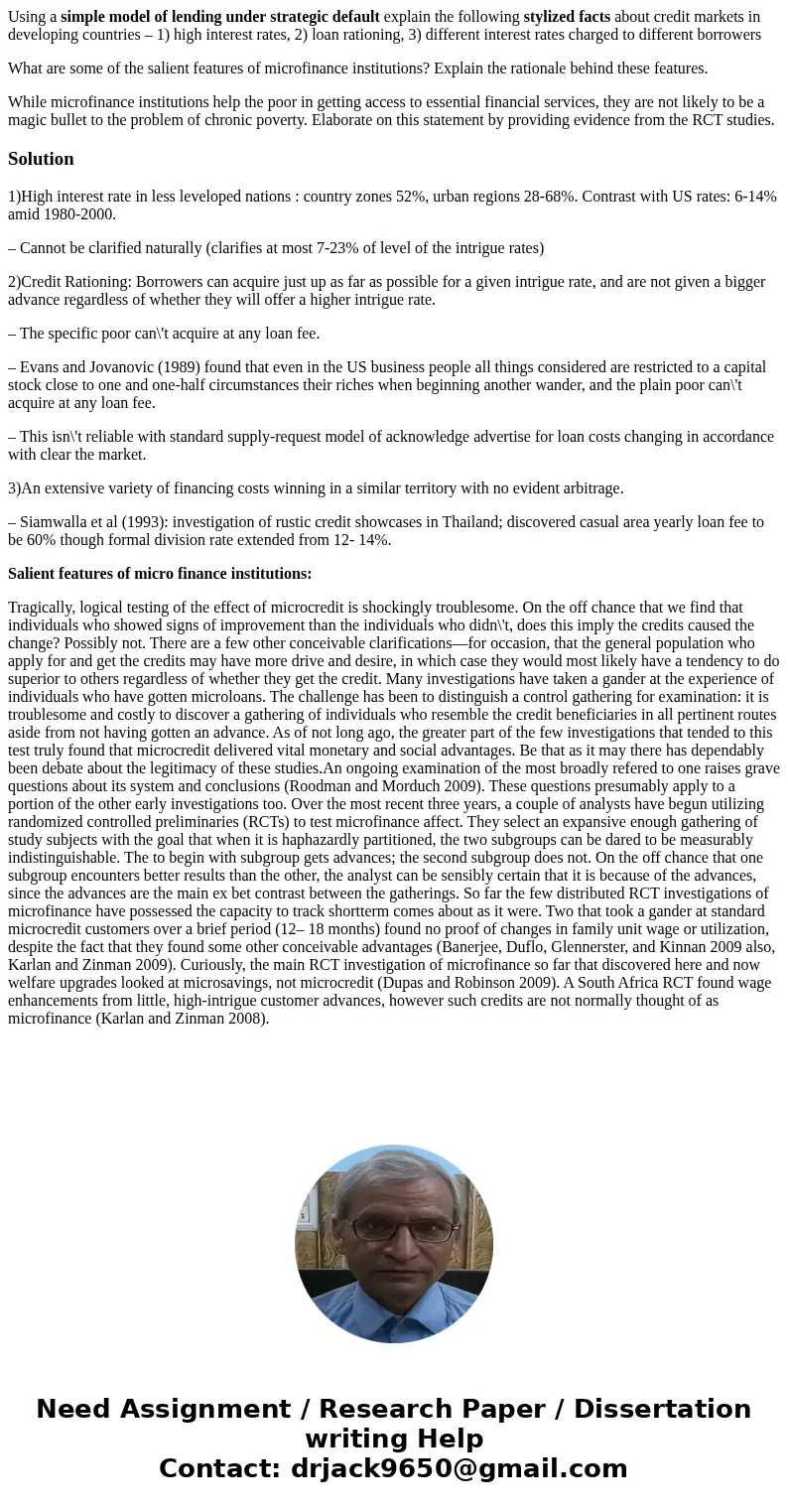Using a simple model of lending under strategic default expl
Using a simple model of lending under strategic default explain the following stylized facts about credit markets in developing countries – 1) high interest rates, 2) loan rationing, 3) different interest rates charged to different borrowers
What are some of the salient features of microfinance institutions? Explain the rationale behind these features.
While microfinance institutions help the poor in getting access to essential financial services, they are not likely to be a magic bullet to the problem of chronic poverty. Elaborate on this statement by providing evidence from the RCT studies.
Solution
1)High interest rate in less leveloped nations : country zones 52%, urban regions 28-68%. Contrast with US rates: 6-14% amid 1980-2000.
– Cannot be clarified naturally (clarifies at most 7-23% of level of the intrigue rates)
2)Credit Rationing: Borrowers can acquire just up as far as possible for a given intrigue rate, and are not given a bigger advance regardless of whether they will offer a higher intrigue rate.
– The specific poor can\'t acquire at any loan fee.
– Evans and Jovanovic (1989) found that even in the US business people all things considered are restricted to a capital stock close to one and one-half circumstances their riches when beginning another wander, and the plain poor can\'t acquire at any loan fee.
– This isn\'t reliable with standard supply-request model of acknowledge advertise for loan costs changing in accordance with clear the market.
3)An extensive variety of financing costs winning in a similar territory with no evident arbitrage.
– Siamwalla et al (1993): investigation of rustic credit showcases in Thailand; discovered casual area yearly loan fee to be 60% though formal division rate extended from 12- 14%.
Salient features of micro finance institutions:
Tragically, logical testing of the effect of microcredit is shockingly troublesome. On the off chance that we find that individuals who showed signs of improvement than the individuals who didn\'t, does this imply the credits caused the change? Possibly not. There are a few other conceivable clarifications—for occasion, that the general population who apply for and get the credits may have more drive and desire, in which case they would most likely have a tendency to do superior to others regardless of whether they get the credit. Many investigations have taken a gander at the experience of individuals who have gotten microloans. The challenge has been to distinguish a control gathering for examination: it is troublesome and costly to discover a gathering of individuals who resemble the credit beneficiaries in all pertinent routes aside from not having gotten an advance. As of not long ago, the greater part of the few investigations that tended to this test truly found that microcredit delivered vital monetary and social advantages. Be that as it may there has dependably been debate about the legitimacy of these studies.An ongoing examination of the most broadly refered to one raises grave questions about its system and conclusions (Roodman and Morduch 2009). These questions presumably apply to a portion of the other early investigations too. Over the most recent three years, a couple of analysts have begun utilizing randomized controlled preliminaries (RCTs) to test microfinance affect. They select an expansive enough gathering of study subjects with the goal that when it is haphazardly partitioned, the two subgroups can be dared to be measurably indistinguishable. The to begin with subgroup gets advances; the second subgroup does not. On the off chance that one subgroup encounters better results than the other, the analyst can be sensibly certain that it is because of the advances, since the advances are the main ex bet contrast between the gatherings. So far the few distributed RCT investigations of microfinance have possessed the capacity to track shortterm comes about as it were. Two that took a gander at standard microcredit customers over a brief period (12– 18 months) found no proof of changes in family unit wage or utilization, despite the fact that they found some other conceivable advantages (Banerjee, Duflo, Glennerster, and Kinnan 2009 also, Karlan and Zinman 2009). Curiously, the main RCT investigation of microfinance so far that discovered here and now welfare upgrades looked at microsavings, not microcredit (Dupas and Robinson 2009). A South Africa RCT found wage enhancements from little, high-intrigue customer advances, however such credits are not normally thought of as microfinance (Karlan and Zinman 2008).

 Homework Sourse
Homework Sourse